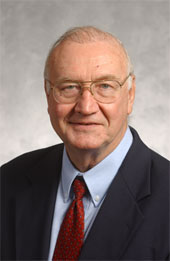Interview: TransHab developer William Schneiderby Dan Schrimpsher
|
| It was not one of those light bulb moments. Actually I had, for some time, felt that with the newer high-strength fibers, such as Kevlar, one could design a lightweight structure for space habitat. |
Dr. Schneider: The original purpose of the TransHab design was for a Mars mission. The habitat for the Mars mission was required to be 600 cubic meters. For an aluminum shell structure—the type that had been conceived—to be that large while being launched (enduring high launch acceleration loads plus high launch vibrations) required a thick wall and heavy wall stiffening. Because of the large surface area the entire habitat became prohibitively heavy. An inflatable, however, could be launched in the collapsed configuration, strapped tightly around a central core so that it could easily withstand the harsh launch environment; once in orbit, where the acceleration and vibration loads are zero, it would be inflated to the required volume. I pulled together a team of engineers and we performed the detail design including deployable micrometeorite and orbital debris (MM/OD) protection. The TransHab was designed and successfully tested to withstand four atmospheres. No airplane cockpit or spacecraft crew module today could be pressurized to that high level. The deployable MM/OD protection was demonstrated to be better than a three inches of solid aluminum.
The large volume afforded by the Mars TransHab module, which could be launched in the Shuttle, soon became a strong consideration for the space station module since it was approximately four to five times as voluminous an a single aluminum space station module.
TSR: Congress cancelled TransHAB in 2000. Was that expected or was the team shocked?
Dr. Schneider: It was not expected by the team and was a true shock. At that time I had already retired from NASA and was teaching at Texas A&M.
TSR: When did you leave NASA for Texas A&M?
Dr. Schneider: August 2000.
TSR: How did Robert Bigelow meet you? Was he looking at inflatable spacecraft before you met or did you introduce the idea to him?
Dr. Schneider: Robert Bigelow read about the TransHab in the May 1999 issue of Air & Space magazine, I believe, and saw that it was cancelled. He contacted NASA and eventually me and asked if I would consult with him, and his newly formed Bigelow Aerospace company, in the development of this inflatable module.
TSR: Was NASA happy to deal with Bigelow Aerospace or were there a lot of bureaucratic headaches? Were you involved in the technology transfer?
Dr. Schneider: NASA was very happy to deal with Robert Bigelow.
TSR: How involved have you been with Bigelow Aerospace as they have taken the TransHAB idea and turned it into Genesis and soon the Nautilus?
Dr. Schneider: I have been very involved with every detail of the design and structural analysis of the Genesis as well as the other larger-sized inflatable.
TSR: Where were you during the launch of Genesis I last month? What did you think of your inflatable ideas finally finding their way into space?
Dr. Schneider: I was on vacation on a mountain top in Colorado. The Russians had delayed the launch approximately six weeks so I went on vacation figuring the launch would transpire two weeks after I returned. But they launched it during my vacation.
| [Robert Bigelow] is much like Howard Hughes. He is into every aspect of the development. He is very bright even in the detailed engineering, even though not his field at all. |
I thought it was fantastic! The module, by design, withstood the launch loads and vibrations (which are much higher on the Russian rocket than on the shuttle), got successfully into a 300-mile Earth orbit, successfully inflated, successfully held the pressure without leaks, and uccessfully deployed the solar cells and many cameras. It is a “dream come true” for the designers and something I am most happy for Robert Bigelow himself.
TSR: Do you think Bigelow’s schedule for a Genesis 2 and a commercial space station by 2015 is reasonable?
Dr. Schneider: Yes I do.
TSR: Have you noticed a difference in the work environment at Bigelow Aerospace and NASA JSC?
Dr. Schneider: There were some differences. Clearly, Bigelow Aerospace does not have the Washington bureaucracy to deal with. Robert Bigelow, himself, is a highly motivated individual with a high level of “can do it” spirit. He, as I have said before, is much like Howard Hughes. He is into every aspect of the development. He is very bright even in the detailed engineering, even though not his field at all.
When I first started going to Las Vegas, since his team was new, many were not as experienced as the strong team of engineers at NASA/JSC that I was used to. However, shortly they became very mature and very technically knowledgeable and experienced. I am truly proud to work with each of them at Bigelow Aerospace.
